What We’re Reading: January 12th edition
Focus Issue: Cellular Dynamics
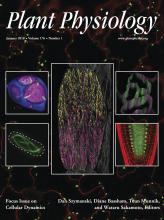 Plant Physiology has released a focus issue on the topic of Cellular Dynamics, which includes Updates on topics ranging from Actin Dynamics to Wall Growth. The Editorial by Szymanski, Bassham, Munnik, and Sakamoto provides an excellent overview of the current state of our understanding of plant cell dynamics. As they observe, “Discovering and unraveling the complexity of these multiscale systems level interactions is a grand challenge in plant research.” The collected reviews span all the parts of the cell (organelles, endomembranes, cytoskeleton) and also new tools such as modeling and light sheet microscopy that are being used to build comprehensive pictures of cells’ dynamic activities. It’s a very nice collection of articles particularly for those who want to catch up on these important topics or for use in teaching. (Summary by Mary Williams) Plant Physiol. http://www.plantphysiol.org/content/176/1
Plant Physiology has released a focus issue on the topic of Cellular Dynamics, which includes Updates on topics ranging from Actin Dynamics to Wall Growth. The Editorial by Szymanski, Bassham, Munnik, and Sakamoto provides an excellent overview of the current state of our understanding of plant cell dynamics. As they observe, “Discovering and unraveling the complexity of these multiscale systems level interactions is a grand challenge in plant research.” The collected reviews span all the parts of the cell (organelles, endomembranes, cytoskeleton) and also new tools such as modeling and light sheet microscopy that are being used to build comprehensive pictures of cells’ dynamic activities. It’s a very nice collection of articles particularly for those who want to catch up on these important topics or for use in teaching. (Summary by Mary Williams) Plant Physiol. http://www.plantphysiol.org/content/176/1
Review: Vacuolar transporters – then and now
 Plant Physiol. Plant vacuolar transporters are essential for many processes in the plant. Studies on vacuolar transporters accelerated in the 1970s and 1980s due to new methods to isolate vacuoles for biochemical and electrophysiological studies. More vacuolar transporters were identified in the 1990s with novel methods such as heterologous complementation, T-DNA insertion mutants and proteomic studies. However, there still remain many essential transporters that have not been characterized at the molecular or biochemical level. This Founders’ Review by Martinoia covers the history of vacuolar transporters, current research on transporters involved in a variety of cellular functions (vacuolar pH, detoxification of xenobiotics and heavy metals, carboxylate and sugar transport, stomatal function, hormone homeostasis), and future questions in the vacuolar transporter field. (Summary by Julia Miller) Plant Physiol. 10.1104/pp.17.01481
Plant Physiol. Plant vacuolar transporters are essential for many processes in the plant. Studies on vacuolar transporters accelerated in the 1970s and 1980s due to new methods to isolate vacuoles for biochemical and electrophysiological studies. More vacuolar transporters were identified in the 1990s with novel methods such as heterologous complementation, T-DNA insertion mutants and proteomic studies. However, there still remain many essential transporters that have not been characterized at the molecular or biochemical level. This Founders’ Review by Martinoia covers the history of vacuolar transporters, current research on transporters involved in a variety of cellular functions (vacuolar pH, detoxification of xenobiotics and heavy metals, carboxylate and sugar transport, stomatal function, hormone homeostasis), and future questions in the vacuolar transporter field. (Summary by Julia Miller) Plant Physiol. 10.1104/pp.17.01481
Review: Declining oxygen in the global ocean and coastal waters ($)
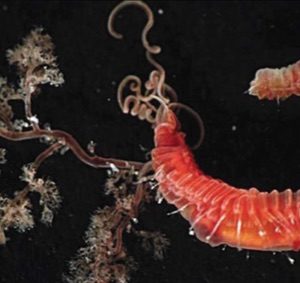 Science. Oxygen levels have been declining in oceans since the middle of the 20th century, largely because of global warming phenomena and human-driven nutrient enrichment of coastal regions. These effects have enhanced microbial oxygen intake, altering the cycles of nutrients and carbon, and lowering oxygen solubility and rates of oxygen atmospheric resupply in some areas. In Breitburg et al., the causes and impact on the biological and biogeochemical processes of declining oxygen in ocean and coastal waters are discussed in detail along with possible strategies for deoxygenation management, specially monitoring strategies, documenting and predictive numerical modeling, and their possible influence on regulations and policy-making. (Summary by Isabel Mendoza) Science 10.1126/science.aam7240
Science. Oxygen levels have been declining in oceans since the middle of the 20th century, largely because of global warming phenomena and human-driven nutrient enrichment of coastal regions. These effects have enhanced microbial oxygen intake, altering the cycles of nutrients and carbon, and lowering oxygen solubility and rates of oxygen atmospheric resupply in some areas. In Breitburg et al., the causes and impact on the biological and biogeochemical processes of declining oxygen in ocean and coastal waters are discussed in detail along with possible strategies for deoxygenation management, specially monitoring strategies, documenting and predictive numerical modeling, and their possible influence on regulations and policy-making. (Summary by Isabel Mendoza) Science 10.1126/science.aam7240
Ten simple rules for biologists learning to program
 PLOS Comp. Biol. Plant biologists need basic programming skills (see Friesner et al. for a discussion of why this is true and how to achieve it). As part of the “Ten Simple Rules” series in PLOS Computational Biology, Carey and Papin describe Ten simple rules for biologists learning to program. This article seeks to encourage experimental biologists to take at least tentative steps into programming by demystifying the process and providing basic information to help get started. The rules are clear and useful. Rule 5, Learn how to ask questions, is particularly good advice no matter what you are doing. If your New Year’s Resolutions include learning to program, here is your portal. (Summary by Mary Williams) PLOS Comp. Biol. 10.1371/journal.pcbi.1005871
PLOS Comp. Biol. Plant biologists need basic programming skills (see Friesner et al. for a discussion of why this is true and how to achieve it). As part of the “Ten Simple Rules” series in PLOS Computational Biology, Carey and Papin describe Ten simple rules for biologists learning to program. This article seeks to encourage experimental biologists to take at least tentative steps into programming by demystifying the process and providing basic information to help get started. The rules are clear and useful. Rule 5, Learn how to ask questions, is particularly good advice no matter what you are doing. If your New Year’s Resolutions include learning to program, here is your portal. (Summary by Mary Williams) PLOS Comp. Biol. 10.1371/journal.pcbi.1005871
Brassinosteroids modulate meristem fate and differentiation of unique inflorescence morphology in Setaria viridis
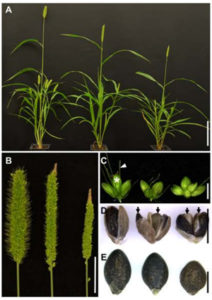 Plant Cell. The yield potential of crops is strongly influenced by floral architecture, a trait determined by the fate of stem cells in meristematic tissue. Meristems themselves are influenced by several factors, including phytohormones such as brassinosteroids (BRs) and gibberellic acid (GA). BRs act locally to promote growth, but can also affect the accumulation of GA to indirectly influence elongation of cells. Yang et al. used a BR deficient mutant of the grass Setaria viridis (bristleless 1, bsl1) to demonstrate that manipulation of BR synthesis can influence floral architecture. The bsl1 mutants had smaller seeds, and were semi-dwarf with an increased number of tillers. Panicles in bsl1 mutants were shorter and thinner than wild-type, lacked bristles, and contained some spikelets with two seeds (wild-type spikelets all produced one seed). Electron microscopy revealed that branch meristems that would normally form bristles instead formed spikelet meristems in bsl1. The phenotypes seen in bsl1 were confirmed by application of propiconazole, a BR synthesis inhibitor. Increasing seed number provides great potential for boosting yield, and this work is readily translatable to the world’s major crops (rice, wheat, maize), as-well-as locally-important subsistence crops. (Summary by Mike Page) Plant Cell 10.1105/tpc.17.00816
Plant Cell. The yield potential of crops is strongly influenced by floral architecture, a trait determined by the fate of stem cells in meristematic tissue. Meristems themselves are influenced by several factors, including phytohormones such as brassinosteroids (BRs) and gibberellic acid (GA). BRs act locally to promote growth, but can also affect the accumulation of GA to indirectly influence elongation of cells. Yang et al. used a BR deficient mutant of the grass Setaria viridis (bristleless 1, bsl1) to demonstrate that manipulation of BR synthesis can influence floral architecture. The bsl1 mutants had smaller seeds, and were semi-dwarf with an increased number of tillers. Panicles in bsl1 mutants were shorter and thinner than wild-type, lacked bristles, and contained some spikelets with two seeds (wild-type spikelets all produced one seed). Electron microscopy revealed that branch meristems that would normally form bristles instead formed spikelet meristems in bsl1. The phenotypes seen in bsl1 were confirmed by application of propiconazole, a BR synthesis inhibitor. Increasing seed number provides great potential for boosting yield, and this work is readily translatable to the world’s major crops (rice, wheat, maize), as-well-as locally-important subsistence crops. (Summary by Mike Page) Plant Cell 10.1105/tpc.17.00816
Maize adaptation to higher latitudes has been facilitated by transposon activities.
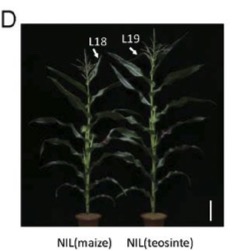 Proc. Natl. Acad. Sci. USA. Flowering is a major determinant of crop adaptation to new environments. Starting from its tropical origins and requirement for short-day conditions to flower, natural selection and breeding have allowed maize to adapt to long-day environments and thus be grown over a wider range of latitudes, from Canada to Chile. Nevertheless, molecular determinants of this adaptation are poorly understood. In this study, the authors describe a flowering-time quantitative trait locus that overlaps with a DNA transposon. This mobile element acts in cis to repress the transcription of a downstream transcription factor called ZmCCT9. Down-regulation of ZmCCT9 induces the activation of the flowering-promoting gene ZCN8, allowing flowering in long-day conditions. The authors further reveal that insertion of this transposon occurred post-domestication since it is not present at this location in teosinte, the wild ancestor of maize. Remarkably, other major flowering-time quantitative trait loci in maize are also associated with transposons, suggesting that mobile elements have been instrumental in maize adaptation to higher latitudes. Altogether, this study provides new insights in the contribution of transposons to developmental plasticity and local adaptation in crop plants. (Summary by Matthias Benoit) Proc. Natl. Acad. Sci. USA. 10.1073/pnas.1718058115
Proc. Natl. Acad. Sci. USA. Flowering is a major determinant of crop adaptation to new environments. Starting from its tropical origins and requirement for short-day conditions to flower, natural selection and breeding have allowed maize to adapt to long-day environments and thus be grown over a wider range of latitudes, from Canada to Chile. Nevertheless, molecular determinants of this adaptation are poorly understood. In this study, the authors describe a flowering-time quantitative trait locus that overlaps with a DNA transposon. This mobile element acts in cis to repress the transcription of a downstream transcription factor called ZmCCT9. Down-regulation of ZmCCT9 induces the activation of the flowering-promoting gene ZCN8, allowing flowering in long-day conditions. The authors further reveal that insertion of this transposon occurred post-domestication since it is not present at this location in teosinte, the wild ancestor of maize. Remarkably, other major flowering-time quantitative trait loci in maize are also associated with transposons, suggesting that mobile elements have been instrumental in maize adaptation to higher latitudes. Altogether, this study provides new insights in the contribution of transposons to developmental plasticity and local adaptation in crop plants. (Summary by Matthias Benoit) Proc. Natl. Acad. Sci. USA. 10.1073/pnas.1718058115
Gene duplication and aneuploidy trigger rapid evolution of herbicide resistance in common waterhemp
 Plant Physiol. Herbicide resistance is a serious problem in contemporary agriculture. One of the most widely used herbicides, glyphosate, interferes with the activity of EPSPS (5-enolpyruvylshikimate-3-phosphate synthase). Koo et al. previously showed that glyphosate-resistant waterhemp (Amaranthus tuberculatus, a common weed in agricultural fields) has an increased copy number of the EPSPS gene and an extra chromosome. In this new report, they demonstrate that the extra gene copies are found on small circular ring chromosomes of various sizes that can be passed between generations. The authors speculate on the mechanism of formation of these ring chromosomes including the involvement of the Breakage-Fusion-Bridge mechanism described initially by Barbara McClintock. (Summary by Mary Williams) Plant Physiol. 10.1104/pp.17.01668
Plant Physiol. Herbicide resistance is a serious problem in contemporary agriculture. One of the most widely used herbicides, glyphosate, interferes with the activity of EPSPS (5-enolpyruvylshikimate-3-phosphate synthase). Koo et al. previously showed that glyphosate-resistant waterhemp (Amaranthus tuberculatus, a common weed in agricultural fields) has an increased copy number of the EPSPS gene and an extra chromosome. In this new report, they demonstrate that the extra gene copies are found on small circular ring chromosomes of various sizes that can be passed between generations. The authors speculate on the mechanism of formation of these ring chromosomes including the involvement of the Breakage-Fusion-Bridge mechanism described initially by Barbara McClintock. (Summary by Mary Williams) Plant Physiol. 10.1104/pp.17.01668
MutS-Homolog2 silencing generates tetraploid meiocytes in tomato (Solanum lycopersicum)
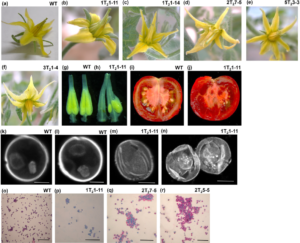 Plant Direct. DNA repair occurs by several independent mechanisms, one of which is the mismatch repair (MMR) pathway. In prokayotes, MutS is a component of the mismatch repair pathway; homologous proteins in eukaryotes are known as MSH (MutS homologs). Sarma et al. set out to develop a hypermutable tomato strain (for genetic screening) by silencing MSH2 through RNAi. Thymine-dimers accumulated in MSH2-silenced lines, demonstrating that DNA repair is hindered. The silenced lines also showed abnormal stamen morphology and decreased fruit set and seed production. Chromosome analysis of the developing pollen revealed an increase in polyploidization as evidenced by tetraploid rather than diploid meiocytes. Root cells in strongly-silenced lines also showed defects in cytokinesis. It remains unclear how MSH2 silencing leads to tetraploidization, but the authors observe that these findings may “contribute to an alternate route to the polyploid formation.” (Summary by Mary Williams) Plant Direct 10.1002/pld3.17
Plant Direct. DNA repair occurs by several independent mechanisms, one of which is the mismatch repair (MMR) pathway. In prokayotes, MutS is a component of the mismatch repair pathway; homologous proteins in eukaryotes are known as MSH (MutS homologs). Sarma et al. set out to develop a hypermutable tomato strain (for genetic screening) by silencing MSH2 through RNAi. Thymine-dimers accumulated in MSH2-silenced lines, demonstrating that DNA repair is hindered. The silenced lines also showed abnormal stamen morphology and decreased fruit set and seed production. Chromosome analysis of the developing pollen revealed an increase in polyploidization as evidenced by tetraploid rather than diploid meiocytes. Root cells in strongly-silenced lines also showed defects in cytokinesis. It remains unclear how MSH2 silencing leads to tetraploidization, but the authors observe that these findings may “contribute to an alternate route to the polyploid formation.” (Summary by Mary Williams) Plant Direct 10.1002/pld3.17
Dynamics of monoterpene formation in spike lavender plants
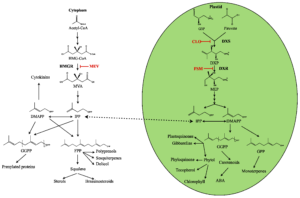 Metabolites. Terpenes are derived from isopentenyl diphosphate (IPP) and dimethylallyl diphosphate (DMAPP), which are produced in two separate pathways: in the cytosol (via mevalonate, MVA) and the plastid (via methyl-D-erythritol-4-phosphate, MEP). The products of terpene metabolism include numerous valuable compounds including many with medicinal properties, and are being explored as target for enhancement through metabolic engineering and synthetic biology. Mendoza-Poudereux et al. used 13CO2 labeling to explore the relative contributions of the MVA and MEP pathway in the production of the lavender Lavandula latifolia Med oil monoterpenes cineole and camphor. Their results suggest the MEP pathway is the predominant source of these terpenes in lavender, even when a key enzyme in the MVA pathway (HMGR) is overexpressed. (Summary by Mary Williams) Metabolites 10.3390/metabo7040065
Metabolites. Terpenes are derived from isopentenyl diphosphate (IPP) and dimethylallyl diphosphate (DMAPP), which are produced in two separate pathways: in the cytosol (via mevalonate, MVA) and the plastid (via methyl-D-erythritol-4-phosphate, MEP). The products of terpene metabolism include numerous valuable compounds including many with medicinal properties, and are being explored as target for enhancement through metabolic engineering and synthetic biology. Mendoza-Poudereux et al. used 13CO2 labeling to explore the relative contributions of the MVA and MEP pathway in the production of the lavender Lavandula latifolia Med oil monoterpenes cineole and camphor. Their results suggest the MEP pathway is the predominant source of these terpenes in lavender, even when a key enzyme in the MVA pathway (HMGR) is overexpressed. (Summary by Mary Williams) Metabolites 10.3390/metabo7040065
Elevation of soybean seed oil content through selection for seed coat shininess
 Nat. Plants. Soybean is the world’s sixth most produced crop and is economically important as a source of protein and oil in animal and human food, as well as having industrial applications. Domestication of soybean has resulted in the absence of seed coat bloom, a powdery coating containing hazardous allergens that protects seeds from predators. Zhang et al. compared a commercial variety of soybean that lacks bloom (Glycine max Williams 82) with two wild relatives (G. soja) with seed coat bloom, and demonstrated that a single nucleotide polymorphism (SNP) in the Bloom1 (B1) gene that confers an amino acid substitution is responsible for the absence of bloom in the commercial variety. Indeed, the presence of the SNP correlates perfectly with absence of bloom across 302 accessions. They then showed that the SNP in B1 also confers increased seed oil content by diminishing B1-mediated repression of transcription factors necessary for fatty acid biosynthesis. (Summary by Mike Page) Nat. Plants 10.1038/s41477-017-0084-7
Nat. Plants. Soybean is the world’s sixth most produced crop and is economically important as a source of protein and oil in animal and human food, as well as having industrial applications. Domestication of soybean has resulted in the absence of seed coat bloom, a powdery coating containing hazardous allergens that protects seeds from predators. Zhang et al. compared a commercial variety of soybean that lacks bloom (Glycine max Williams 82) with two wild relatives (G. soja) with seed coat bloom, and demonstrated that a single nucleotide polymorphism (SNP) in the Bloom1 (B1) gene that confers an amino acid substitution is responsible for the absence of bloom in the commercial variety. Indeed, the presence of the SNP correlates perfectly with absence of bloom across 302 accessions. They then showed that the SNP in B1 also confers increased seed oil content by diminishing B1-mediated repression of transcription factors necessary for fatty acid biosynthesis. (Summary by Mike Page) Nat. Plants 10.1038/s41477-017-0084-7
Speed breeding is a powerful tool to accelerate crop research and breeding
 Nat. Plants. The current rate of crop plant breeding, limited by the long generation time of crop plants, is insufficient to address the needs caused by the enormous increase in the human population accompanied by climate change. Watson et al. have recently presented a method called ‘Speed breeding’ which is based on increasing the period of illumination through supplemental lighting, which greatly shortens crop generation time. Plants grown under speed-breeding conditions flower in approximately half the time than those in standard conditions, making it possible to achieve up to six generations per year in several crop species. This method has been tested for spring wheat, durum wheat, barley, chickpea, pea, and canola. Moreover, development under speed breeding was normal although accelerated, and the harvested seeds from speed-bred plants were completely viable. Additionally, seed production (g per plant) was also similar between speed-breeding and control conditions in canola and chickpea. Hence, this method shows a great potential to accelerate cereal research and cultivar improvement when combined with modern breeding technologies. (Summary by Amey Redkar) Nat. Plants. 10.1038/s41477-017-0083-8
Nat. Plants. The current rate of crop plant breeding, limited by the long generation time of crop plants, is insufficient to address the needs caused by the enormous increase in the human population accompanied by climate change. Watson et al. have recently presented a method called ‘Speed breeding’ which is based on increasing the period of illumination through supplemental lighting, which greatly shortens crop generation time. Plants grown under speed-breeding conditions flower in approximately half the time than those in standard conditions, making it possible to achieve up to six generations per year in several crop species. This method has been tested for spring wheat, durum wheat, barley, chickpea, pea, and canola. Moreover, development under speed breeding was normal although accelerated, and the harvested seeds from speed-bred plants were completely viable. Additionally, seed production (g per plant) was also similar between speed-breeding and control conditions in canola and chickpea. Hence, this method shows a great potential to accelerate cereal research and cultivar improvement when combined with modern breeding technologies. (Summary by Amey Redkar) Nat. Plants. 10.1038/s41477-017-0083-8
Perception and reading strategies of scientific papers depends on academic career stage
 PLOS One. Katharine Hubbard (@KEHplantsci) and Sonja Dunbar (@PlantSciSonja) are enthusiastic proponents of student-centered teaching, including guiding undergraduate students through the reading of scientific papers. In this new work they’ve evaluated how undergraduate students compare to graduate students, postdocs and PIs in their approach to and appreciation of scientific papers. Their key conclusions: “We propose a model for the development of literature processing skills, and consider the need for training strategies to help inexperienced readers engage with primary literature, and therefore develop important skills that underpin scientific careers. We also encourage researchers to be mindful of language used when writing papers, and to be more inclusive of diverse audiences when disseminating their work.” Good advice for all of us. (Summary by Mary Williams) PLOS One 10.1371/journal.pone.0189753
PLOS One. Katharine Hubbard (@KEHplantsci) and Sonja Dunbar (@PlantSciSonja) are enthusiastic proponents of student-centered teaching, including guiding undergraduate students through the reading of scientific papers. In this new work they’ve evaluated how undergraduate students compare to graduate students, postdocs and PIs in their approach to and appreciation of scientific papers. Their key conclusions: “We propose a model for the development of literature processing skills, and consider the need for training strategies to help inexperienced readers engage with primary literature, and therefore develop important skills that underpin scientific careers. We also encourage researchers to be mindful of language used when writing papers, and to be more inclusive of diverse audiences when disseminating their work.” Good advice for all of us. (Summary by Mary Williams) PLOS One 10.1371/journal.pone.0189753
Ten simple rules for drawing scientific comics
 PLOS Comp. Biol. No doubt, science communication is a struggle for many scientists and science institutions. There is an increasing need to improve public science understanding and/or engagement. Good science communication is crucial to help recruit next generation scientist, highlight science’s role and impact in day-to-day life, and even help with dissemination of findings among the science community itself. According to McDermott et al., science-based comics, with the help of social media, could be a great asset in this task. In this unusual and refreshing publication they explain their decalogue with the “do’s and don’ts” for designing useful (and funny!) scientific comics. (Summary by Isabel Mendoza) PLOS Comp. Biol. 10.1371/journal.pcbi.1005845
PLOS Comp. Biol. No doubt, science communication is a struggle for many scientists and science institutions. There is an increasing need to improve public science understanding and/or engagement. Good science communication is crucial to help recruit next generation scientist, highlight science’s role and impact in day-to-day life, and even help with dissemination of findings among the science community itself. According to McDermott et al., science-based comics, with the help of social media, could be a great asset in this task. In this unusual and refreshing publication they explain their decalogue with the “do’s and don’ts” for designing useful (and funny!) scientific comics. (Summary by Isabel Mendoza) PLOS Comp. Biol. 10.1371/journal.pcbi.1005845



